The blue bicolor Ragdoll cat is a truly captivating feline with its striking blue-gray coat and signature white markings. Known for their affectionate nature and unique beauty, these cats have become a favorite among pet lovers worldwide.
Their distinct bicolor pattern, featuring a white inverted “V” on the face, white legs, and a soft bluish-gray body, makes them stand out among other Ragdoll color variations.
What makes the blue bicolor Ragdoll so special isn’t just its stunning coat but also its gentle and loving temperament. These cats are often described as “puppy-like” because they follow their owners around the house and crave attention.
Unlike some independent cat breeds, Ragdolls love being held and will often flop into their owner’s arms, earning them the nickname “floppy cats.” Their calm and docile nature makes them an excellent choice for families, seniors, and even first-time cat owners.
Their popularity has soared in recent years, especially among those looking for an affectionate and easygoing indoor pet.
Ragdolls, including the blue bicolor variety, are well-suited for apartment living due to their laid-back personality and minimal grooming needs. Their stunning blue eyes, silky fur, and friendly disposition make them one of the most desirable purebred cats.
Due to their rarity and aesthetic appeal, the demand for blue bicolor Ragdolls remains high, with many breeders specializing in this particular pattern.
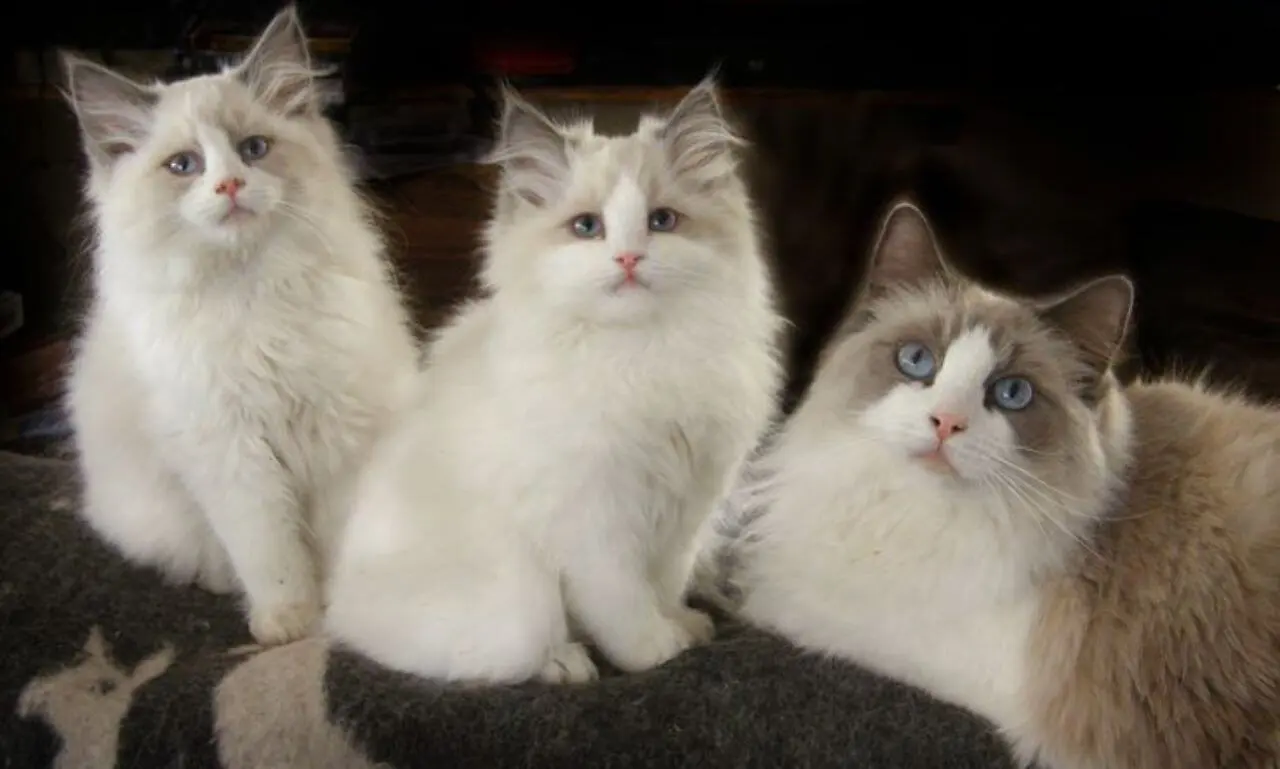
While they are not the most common Ragdoll variety, their elegance and loving nature make them a highly sought-after choice for cat lovers.
Whether you’re drawn to their luxurious appearance or their affectionate personality, this breed is a perfect choice for those seeking a devoted feline companion.
Breed Overview Table
Table of Contents
- 1 What Is a Blue Bicolor Ragdoll Cat?
- 2 Personality and Temperament
- 3 Blue Bicolor Ragdoll Kitten – What to Expect?
- 4 Blue Bicolor Ragdoll Kittens for Sale – Where to Buy?
- 5 Blue Bicolor Ragdoll Cat~Care Guide
- 6 Common Health Issues in Blue Bicolor Ragdolls
- 7 Comparison with Seal, Lilac, Chocolate, and Flame Bicolor Ragdolls
| Trait | Description |
| Breed Name | Ragdoll |
| Color Pattern | Blue Bicolor (blue-gray body with white markings) |
| Eye Color | Bright Blue |
| Personality | Affectionate, Gentle, Social, Playful |
| Size | Large (Males: 15-20 lbs, Females: 10-15 lbs) |
| Lifespan | 12-17 years |
| Coat Type | Medium to Long, Silky |
| Grooming Needs | Moderate (Brushing 2-3 times a week) |
| Activity Level | Moderate (Enjoys play but not overly energetic) |
| Good for Families? | Yes, great with children and other pets |
| Indoor or Outdoor? | Best kept indoors |
| Intelligence Level | High (Can learn tricks, enjoys puzzle toys) |
What Is a Blue Bicolor Ragdoll Cat?
The blue bicolor Ragdoll is one of the most sought-after variations of the Ragdoll breed, known for its stunning coat pattern and affectionate nature.
These cats feature a blue-gray body with symmetrical white markings, creating a striking contrast that enhances their beauty. Their soft, silky fur and deep blue eyes add to their elegance, making them highly desirable among cat enthusiasts.
Beyond their appearance, blue bicolor Ragdolls are cherished for their gentle, affectionate temperament. They are often described as “puppy-like” due to their strong attachment to their owners and love for human companionship.
Unlike many independent cat breeds, Ragdolls enjoy being held, following their humans around the house, and even learning basic commands.
Defining the Blue Bicolor Ragdoll Cat Pattern
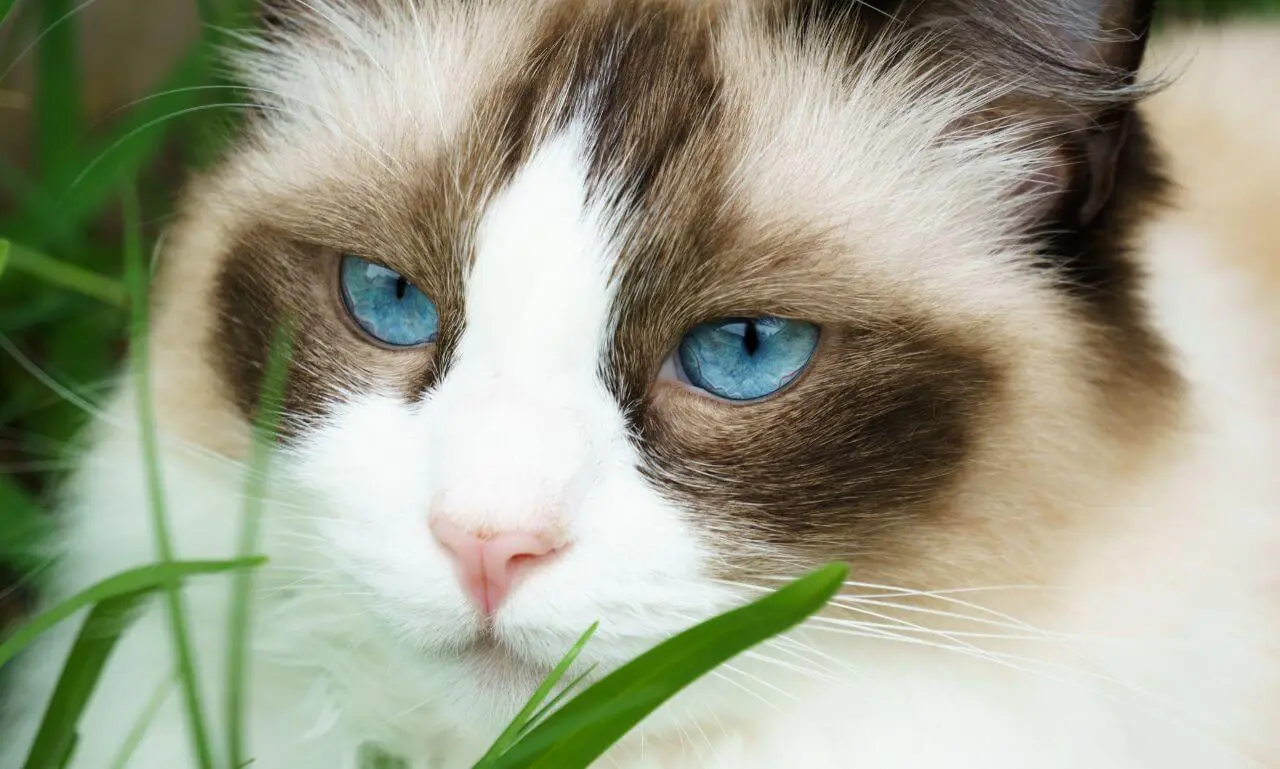
The bicolor pattern in Ragdolls is characterized by a mix of two distinct colors, with white markings covering certain areas of the body.
The blue bicolor Ragdoll Cat specifically has a soft blue-gray (diluted black) coat combined with well-defined white areas.
Key features of the blue bicolor pattern include:
- A white inverted “V” on the face, which must be symmetrical for show-quality cats.
- White legs and paws, resembling “mittens” on the front and full white boots on the hind legs.
- A predominantly blue-gray body, with darker shading on the ears and tail.
- A pink nose and paw pads, unlike some other Ragdoll variations.
This color combination gives blue bicolor Ragdolls a unique, elegant look that makes them stand out among other Ragdoll coat patterns.
Difference Between Blue Bicolor and Other Ragdoll Coat Colors
Ragdolls come in several color variations, with seal, chocolate, and lilac being some of the most common. Here’s how the blue bicolor compares to these other colors:
| Color | Description |
| Blue Bicolor | Blue-gray body with white markings, bright blue eyes. |
| Seal Bicolor | Dark brown (seal) body with white markings. |
| Chocolate Bicolor | Warm, milk-chocolate body with white markings. |
| Lilac Bicolor | Light, silvery-gray body with white markings (lighter than blue). |
The main difference between these colors is the base coat color. Blue bicolor Ragdolls have a cool-toned grayish-blue coat, whereas seal Ragdolls have a much darker brown shade.
Chocolate Ragdolls are lighter than seal, while lilac is the palest of all, appearing almost frosty.
Genetics Behind the Blue Bicolor Pattern
The blue bicolor Ragdoll’s coat color is a result of specific genetic traits that determine both color and pattern. Here’s how it works:
- Dilution Gene (d) – The blue color in Ragdolls is actually a diluted form of black, caused by a recessive gene. This means both parents must carry the dilution gene for a kitten to be born with a blue coat.
- Bicolor Gene (Wb) – The bicolor pattern is controlled by the white spotting gene, which affects how much white appears on the coat.
- Selective Breeding – Breeders carefully pair Ragdoll parents to ensure the proper blue bicolor markings, avoiding excessive white (high white Ragdolls) or asymmetrical patterns.
The combination of these genetic factors results in the stunning blue bicolor Ragdoll—a cat that is as genetically fascinating as it is beautiful.
Personality and Temperament
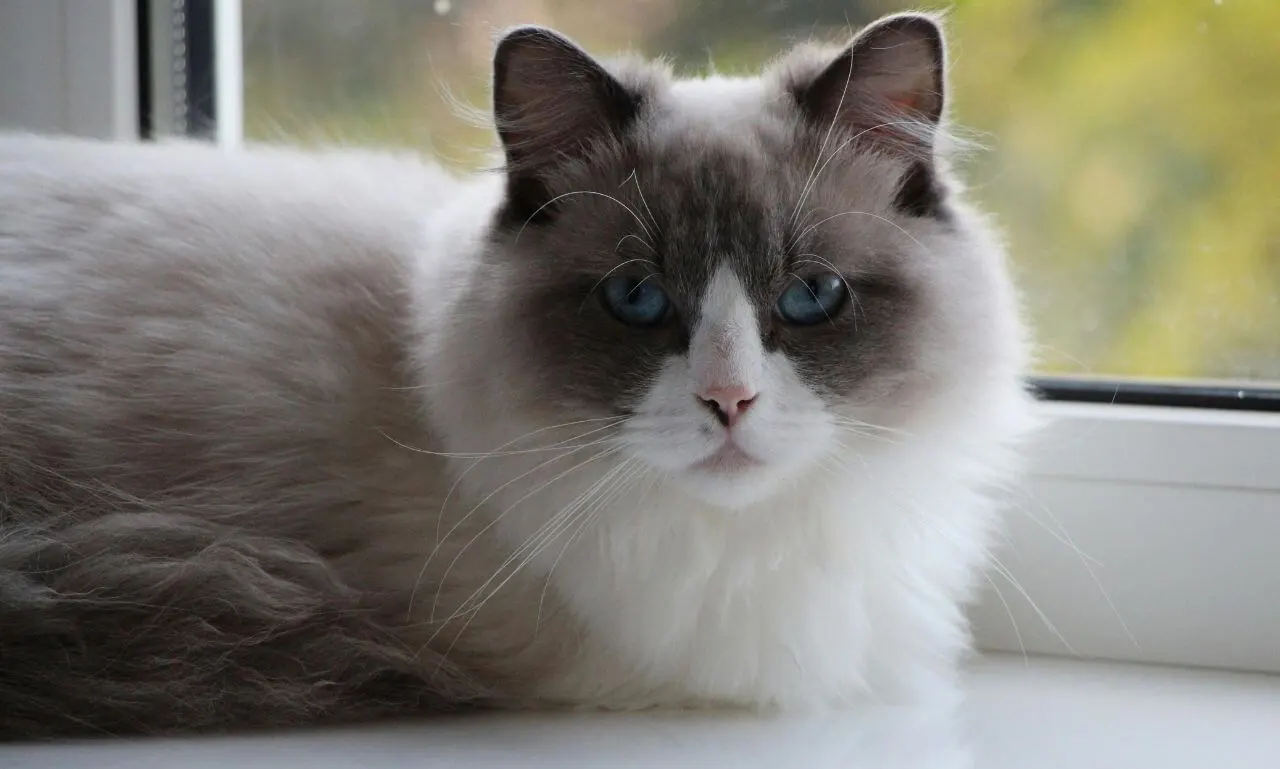
The blue bicolor Ragdoll cat is not only admired for its striking appearance but also for its gentle and affectionate personality. These cats are often described as loving, social, and people-oriented, making them one of the most desirable cat breeds for companionship.
Unlike some independent breeds, Ragdolls form strong bonds with their owners and thrive on human interaction.
Their calm and friendly nature makes them a perfect choice for families, singles, and even seniors looking for a devoted feline friend.
Whether lounging beside you, following you from room to room, or greeting you at the door, the blue bicolor Ragdoll cat is always eager to be part of your life.
Affectionate and Social Nature
One of the standout traits of the blue bicolor Ragdoll is its loving and social demeanor. These cats are known for:
- Being extremely affectionate, often seeking cuddles and lap time.
- Enjoying human companionship and following their owners around the house.
- Rarely displaying aggressive or territorial behavior, making them great for multi-pet households.
- Loving attention and even tolerating being carried like a baby, earning them the nickname “floppy cats.”
Unlike many other breeds, Ragdolls prefer being with their humans and do not like to be left alone for long periods. If you work long hours, consider adopting a second pet to keep them company.
Intelligence and Trainability
The blue bicolor Ragdoll is not only affectionate but also highly intelligent. This breed is known for:
- Learning tricks like fetch, sit, and even walking on a leash.
- Recognizing routines and adapting well to household schedules.
- Being receptive to positive reinforcement training, responding well to treats and praise.
- Enjoying puzzle toys and interactive games that stimulate their mind.
While not as hyperactive as some other intelligent breeds, Ragdolls love engaging with their owners and can be trained to follow simple commands. Their docile yet curious nature makes training an enjoyable experience for both the cat and the owner.
Compatibility with Families, Kids, and Other Pets
The blue bicolor Ragdoll is an excellent choice for families due to its calm and friendly temperament. These cats:
- Get along exceptionally well with children, tolerating gentle play and cuddles.
- Are friendly toward other pets, including dogs and other cats, especially when properly introduced.
- Are not aggressive and rarely scratch or bite, making them safe for kids and seniors.
Their patient and tolerant nature makes them ideal for households with multiple pets or young children. However, it’s essential to teach kids how to handle cats gently to ensure a positive interaction.
Whether you live in a bustling household or a quiet home, the blue bicolor Ragdoll will happily adapt as long as they receive love, attention, and companionship.
Blue Bicolor Ragdoll Kitten – What to Expect?
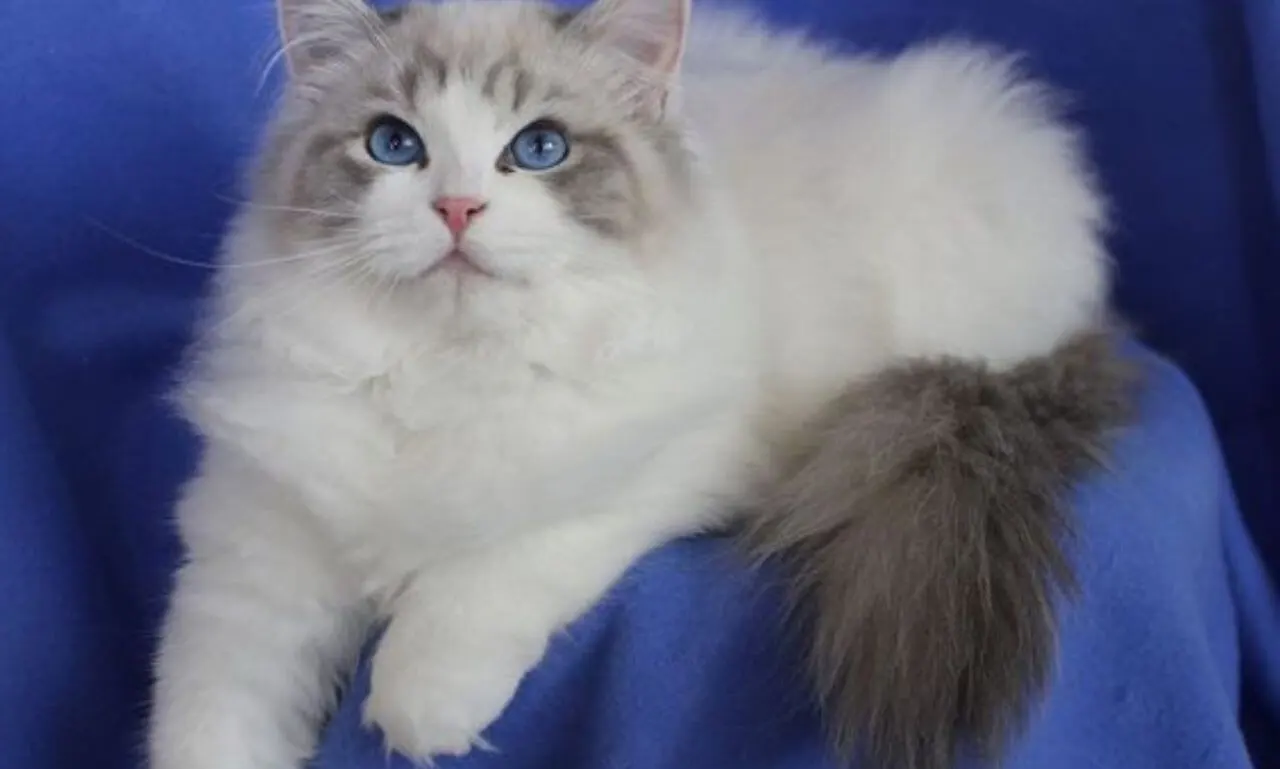
Bringing home a blue bicolor Ragdoll kitten is an exciting experience, as these fluffy companions grow into stunning and affectionate adult cats.
However, Ragdoll kittens go through several developmental stages, including changes in their coat color and personality. Understanding what to expect during their growth will help you provide the best care for your kitten.
Unlike some other breeds, Ragdolls take longer to mature both physically and emotionally. While most cats reach adulthood within a year, Ragdolls may take up to three to four years to fully develop their size, coat, and personality.
Growth Stages from Kitten to Adult
Ragdoll kittens go through distinct stages of growth, and their personality and physical features evolve over time:
| Age | Growth Milestones |
| 0-8 Weeks | Dependent on the mother, eyes are blue but may appear lighter. Coat begins to develop patterns. |
| 8-12 Weeks | Kittens are weaned and ready to go to new homes. Playful and curious, they need socialization. |
| 3-6 Months | Growth spurts begin. The body elongates, and the coat thickens. They develop their personality. |
| 6-12 Months | Adolescence begins. They become more active and start forming strong bonds with their owners. |
| 1-3 Years | Full personality emerges. Coat and color continue to develop, and they reach their adult size. |
| 3-4 Years | Full maturity is achieved. The Ragdoll becomes a large, muscular cat with a well-developed coat. |
Ragdolls are a slow-maturing breed, which means you’ll see gradual changes in their coat, eye color, and size over the years.
Coat Color Changes as They Mature
One fascinating feature of blue bicolor Ragdoll kittens is that they are born almost completely white. Their true color and markings develop gradually over the first few months. Here’s what to expect:
- Newborn to 2 Weeks: Kittens are born white, with only slight hints of blue-gray appearing on the ears and tail.
- 2-8 Weeks: The blue color starts becoming more visible, especially on the face, ears, and tail.
- 3-6 Months: The bicolor pattern becomes more defined, and the contrast between blue and white increases.
- 6-12 Months: The coat continues to darken, but some Ragdolls may still look lighter than expected.
- 1-3 Years: The full adult coat color is established, and the fur becomes thicker and softer.
This slow transformation is part of what makes Ragdolls so unique, as their appearance gradually changes over time.
Socialization and Training Tips for Kittens
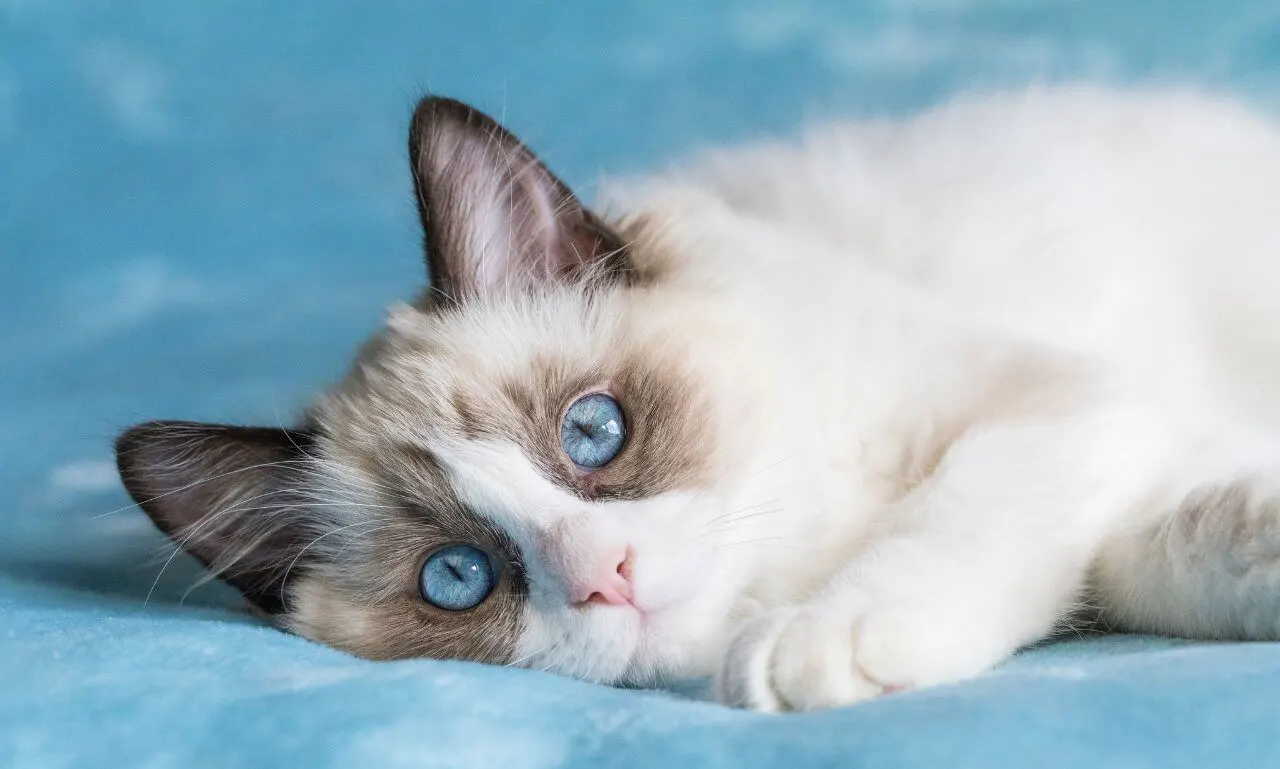
Proper socialization and training are essential to raising a well-adjusted blue bicolor Ragdoll kitten. Since Ragdolls are naturally friendly, they respond well to early handling and positive reinforcement.
Here’s how to ensure your kitten grows into a confident and affectionate cat:
- Early Socialization:
- Introduce your kitten to different environments, sounds, and people to prevent shyness.
- Allow supervised playtime with other pets to encourage good social behavior.
- Litter Training:
- Ragdolls are naturally clean and usually learn litter training quickly.
- Use a large, low-sided litter box in a quiet location for easy access.
- Basic Training:
- Teach your kitten to respond to their name and simple commands like “come” or “no.”
- Use positive reinforcement, such as treats and praise, to encourage good behavior.
- Interactive Play:
- Engage them with toys, feather wands, and puzzle feeders to stimulate their intelligence.
- Provide a scratching post to prevent furniture damage.
- Handling and Grooming:
- Get your kitten used to being picked up and held gently.
- Start brushing their fur early to maintain their soft, silky coat.
By investing time in socializing and training your kitten early on, you’ll help them grow into a loving, well-behaved companion that thrives in any home environment.
Blue Bicolor Ragdoll Kittens for Sale – Where to Buy?
Finding a blue bicolor Ragdoll kitten for sale requires careful research to ensure you get a healthy, well-bred pet.
While Ragdolls are widely available, their popularity has led to unethical breeding practices, making it crucial to find a reputable breeder or consider adoption.
Understanding the best sources and the difference between buying and adopting will help you make an informed decision.
Choosing a Reputable Breeder
Not all breeders prioritize the health and well-being of their kittens. A responsible breeder ensures proper socialization, health screenings, and ethical breeding practices. Here’s how to find a reputable breeder and avoid kitten mills.
Checklist for Selecting a Trusted Breeder:
- Provides health guarantees and genetic testing for common Ragdoll health issues.
- Allows you to visit their cattery and see where the kittens are raised.
- Has a strong reputation with positive reviews and references.
- Is registered with organizations like TICA (The International Cat Association) or CFA (Cat Fanciers’ Association).
- Raises kittens in a clean, home-like environment rather than cages.
- Prioritizes temperament and socialization, handling kittens daily to ensure they are friendly.
Warning Signs of Kitten Mills:
- Selling kittens at suspiciously low prices or without paperwork.
- No health screenings, vaccinations, or genetic testing were provided.
- Won’t allow you to visit or insists on meeting in a public place.
- Kittens appear sickly, malnourished, or overly timid due to lack of proper care.
- Frequently has multiple litters available at once, a sign of overbreeding.
Price Range of Blue Bicolor Ragdoll Cat Kittens:
The cost of a blue bicolor Ragdoll kitten varies based on breeder’s reputation, lineage, and location. Here’s what to expect:
| Quality | Price Range (USD) | Details |
| Pet Quality | $1,200 – $2,500 | Standard Ragdoll with minor imperfections in markings. |
| Show Quality | $2,500 – $4,000 | Perfect markings and ideal temperament for cat shows. |
| Breeding Quality | $3,500+ | From champion bloodlines, suitable for ethical breeding. |
Buying from a responsible breeder may be more expensive upfront, but it ensures a well-socialized, healthy kitten with fewer long-term health risks.
Adoption vs. Buying – What’s the Best Choice?

If you’re open to alternatives, adoption is a great way to provide a loving home to a Ragdoll in need. While kittens are less common in shelters, adult Ragdolls often become available through rescues.
Pros and Cons of Adopting vs. Purchasing:
| Factor | Buying from a Breeder | Adopting from a Rescue |
| Health History | Comes with detailed medical and genetic records. | May have unknown medical history. |
| Age Options | Mostly kittens. | Kittens are rare, but adults are available. |
| Cost | Higher upfront cost ($1,200+). | Lower adoption fees ($100-$500). |
| Socialization | Kittens are raised with human interaction. | May require extra patience if rescued from neglect. |
| Availability | Specific colors and patterns can be chosen. | Limited selection based on what’s available. |
Rescue Organizations That May Have Ragdolls:
- Ragdoll Rescue USA & Canada – Specializes in finding homes for Ragdolls.
- Purebred Cat Rescue – Works with various breeds, including Ragdolls.
- Local Animal Shelters – Occasionally have purebred Ragdolls or Ragdoll mixes.
- Petfinder & Adopt-a-Pet – Online platforms that list available Ragdolls in rescues.
Tips for Adopting a Healthy Blue Bicolor Ragdoll Kitten:
- Be patient – Finding a blue bicolor Ragdoll in a shelter may take time.
- Ask about medical history – Ensure vaccinations and health screenings are up to date.
- Consider an adult Ragdoll – Many purebred Ragdolls in rescues are adults needing loving homes.
- Visit the shelter or foster home – Observe temperament and socialization.
Adopting or buying both have their advantages, but the best choice depends on your lifestyle, budget, and willingness to wait for the perfect match.
Blue Bicolor Ragdoll Cat~Care Guide
Caring for a blue bicolor Ragdoll involves a combination of proper grooming, nutrition, and mental stimulation.
These cats have long, silky fur that requires regular maintenance, and their laid-back personality means they need encouragement to stay active. Providing the right diet and playtime will keep them healthy and happy.
Grooming Needs
Ragdolls have semi-long fur that is prone to tangling, so a consistent grooming routine is essential to maintain their luxurious coat.
Coat Maintenance and Brushing Frequency:
- Brush your Ragdoll at least 3-4 times a week using a stainless-steel comb or soft bristle brush.
- Pay extra attention to areas prone to matting, such as behind the ears, under the legs, and around the neck.
- Use a detangling spray if you notice knots forming.
- Ragdolls don’t have an undercoat, so they shed less than other long-haired breeds, but seasonal shedding still occurs.
Preventing Matting and Shedding Control:
- Regular brushing helps remove loose fur and prevents mats from forming.
- Provide a high-protein diet, as poor nutrition can lead to excessive shedding.
- Bathe your Ragdoll once every few months if necessary, using a mild cat shampoo.
- Keep a lint roller handy, as Ragdoll fur tends to stick to furniture and clothing.
Nutrition and Diet
Feeding your Ragdoll the right diet is key to maintaining their coat, muscle tone, and overall health.
Best Food for Ragdoll Cats:
- High-protein, grain-free diets are ideal, as Ragdolls need plenty of protein for their large, muscular build.
- Wet food provides hydration and essential nutrients, while dry kibble supports dental health.
- Look for cat food rich in Omega-3 and Omega-6 fatty acids to maintain a soft, shiny coat.
- Avoid fillers like corn, soy, and artificial preservatives, which can lead to obesity and digestive issues.
Feeding Schedule for Kittens and Adults:
- Kittens (2-6 months): Feed 4-5 small meals per day, as they need more nutrients for growth.
- 6 months – 1 year: Reduce to 3 meals a day, gradually transitioning to adult cat food.
- Adult Ragdolls (1 year+): Feed 2 meals per day, with occasional treats or a small portion of wet food for variety.
- Always provide fresh water to prevent dehydration.
Exercise and Playtime
Though Ragdolls are known for their calm and affectionate nature, they still need regular activity to prevent obesity and keep their minds engaged.
How to Keep Your Ragdoll Active Indoors:
- Ragdolls enjoy interactive play, so schedule daily play sessions to keep them engaged.
- They are not as hyperactive as some breeds, but they still love chasing feather wands, laser pointers, and balls.
- Consider getting a cat tree or climbing shelves to encourage jumping and stretching.
Best Toys and Activities for Mental Stimulation:
- Puzzle feeders – Stimulate their intelligence while controlling food intake.
- Cat tunnels and hideouts – Provide a fun space to explore and play.
- Fishing rod toys with feathers – Mimic natural hunting instincts.
- Interactive electronic toys – Keep them engaged even when you’re not home.
- Training sessions with treats – Teach tricks like fetching or coming when called.
Providing a mix of physical exercise and mental stimulation will help your blue bicolor Ragdoll stay healthy, happy, and well-behaved.
Common Health Issues in Blue Bicolor Ragdolls
Like all Ragdolls, blue bicolor Ragdolls are generally healthy, but they are prone to certain genetic conditions. Regular vet checkups and a healthy lifestyle can help manage or prevent many of these issues.
Hypertrophic Cardiomyopathy (HCM) Risk
HCM is the most common heart disease in Ragdolls and can lead to heart failure if not managed properly.
- It causes the thickening of the heart muscles, leading to poor blood circulation.
- Symptoms include lethargy, rapid breathing, loss of appetite, and weakness.
- The disease is hereditary, so responsible breeders screen their cats to reduce the risk.
- There is no cure, but early detection through regular echocardiograms can help manage the condition with medication.
Polycystic Kidney Disease (PKD)
PKD is a genetic disorder that causes fluid-filled cysts to develop in the kidneys, leading to kidney failure over time.
- Some Ragdolls inherit this condition, though it is more common in Persian and Himalayan breeds.
- Signs include increased thirst, frequent urination, weight loss, and poor appetite.
- A DNA test can detect PKD, and responsible breeders avoid breeding affected cats.
- A low-phosphorus diet, hydration, and regular vet checkups help manage symptoms in affected cats.
Importance of Regular Vet Checkups
Routine veterinary care is crucial in detecting and preventing health issues before they become serious.
- Annual wellness exams help monitor heart and kidney health.
- Dental checkups prevent gum disease, which is common in Ragdolls.
- Vaccinations protect against common feline illnesses.
- Regular blood work and ultrasounds help catch hidden health problems early.
With proper care, blue bicolor Ragdoll cats can live 12-17 years, enjoying a healthy and happy life.
Comparison with Seal, Lilac, Chocolate, and Flame Bicolor Ragdolls
Each Ragdoll color has its unique characteristics, but their affectionate nature remains the same.
| Color | Description | Appearance Traits |
| Blue Bicolor | Soft blue-gray points with a white inverted “V” on the face | Elegant and cool-toned, giving a refined look |
| Seal Bicolor | Dark brown points with a white “V” and a creamy body | The most traditional and classic Ragdoll look |
| Lilac Bicolor | Pale, pinkish-gray points with a white contrast | The lightest and rarest Ragdoll color |
| Chocolate Bicolor | Warm, milk-chocolate-colored points with white bicolor markings | A rich, luxurious-looking coat |
| Flame Bicolor | Orange-red points with a white inverted “V” and chest | Vibrant and eye-catching, often with freckles on the nose |
Each color is equally affectionate and loving, but blue and seal bicolor Ragdolls are among the most popular due to their balanced, classic look.
Which Color Pattern Is the Most Popular?
While all Ragdoll colors have their admirers, seal and blue bicolor Ragdolls tend to be the most sought-after.
- Seal bicolor Ragdolls are widely recognized and considered the “classic” Ragdoll.
- Blue bicolor Ragdolls are loved for their soft, dreamy appearance and elegant contrast.
- Lilac and chocolate Ragdolls are rarer due to their genetic traits.
- Flame Ragdolls are unique and vibrant but less common in breeding programs.
Ultimately, choosing a Ragdoll color is a matter of personal preference, as their loving temperament remains the same across all varieties.
Conclusion
Blue bicolor Ragdolls are a stunning and affectionate breed known for their striking coat pattern, gentle temperament, and social nature.
They require proper care, regular grooming, and a balanced diet to stay healthy and happy. Like all Ragdolls, they are prone to certain genetic conditions, making routine vet checkups essential.
If you’re considering bringing one home, choose a reputable breeder or adoption center to ensure a healthy and well-socialized kitten. Responsible breeding helps prevent hereditary health issues and ensures ethical practices.
Owning a blue bicolor Ragdoll is a rewarding experience, as they bring love, companionship, and elegance to any home. With the right care, they can become a cherished family member for years to come.
FAQs About Blue Bicolor Ragdoll Cats
Are blue bicolor Ragdolls rare?
Blue bicolor Ragdolls are not the rarest, but they are highly sought after due to their striking contrast and soft grayish-blue tones. Some colors, like lilac and flame, are rarer.
What is a bicolor Ragdoll?
A bicolor Ragdoll has a distinct coat pattern featuring a white inverted “V” on the face, a white chest and belly, and colored points on the ears, tail, and parts of the face.
What is the difference between blue bicolor and blue lynx Ragdolls?
Blue bicolor Ragdolls have solid blue-gray points, while blue lynx Ragdolls have tabby-like stripes within their blue markings, giving them a more patterned appearance.
How much is a blue bicolor Ragdoll?
The price can range from $1,500 to $3,500, depending on lineage, breeder reputation, and location. Show-quality kittens tend to be more expensive.
Why are Ragdoll cats so expensive?
Ragdolls are selectively bred for their unique temperament, coat patterns, and size. Ethical breeding, genetic testing, and early socialization contribute to the higher cost.
What is the rarest bicolor cat?
Lilac bicolor Ragdolls are among the rarest due to their light pinkish-gray coloring and the recessive genes required to produce them.
How much does a blue bicolor Ragdoll kitten cost?
A blue bicolor Ragdoll kitten typically costs $1,500 to $2,500, depending on the breeder and quality of the kitten.
Are blue bicolor Ragdolls hypoallergenic?
No, Ragdolls are not hypoallergenic. While they have minimal undercoats and shed less than some breeds, they still produce allergens that can trigger reactions.
How long do blue bicolor Ragdolls live?
With proper care, Ragdolls typically live between 12 to 17 years, with some even reaching 20 years in a healthy home environment.
Do blue bicolor Ragdoll cats shed a lot?
They have a soft, semi-long coat that sheds moderately. Regular brushing (at least twice a week) helps reduce shedding and prevents matting.
Are they good for first-time cat owners?
Yes! Blue bicolor Ragdolls are gentle, affectionate, and easygoing, making them a great choice for first-time cat owners and families with children or other pets.
- Lynx Bicolor Ragdoll Guide: Colors, Personality & Buying Kittens
- Ragdoll Cat Eye Discharge – Causes, Treatment & Prevention
- Ragdoll Cat Kidney Problems – Causes, Symptoms & Treatments
- Ragdoll Cat Health Issues & Diseases – Symptoms, and Treatment
- Ragdoll Cat Colors and Patterns: A Complete Guide for Cat Lovers

